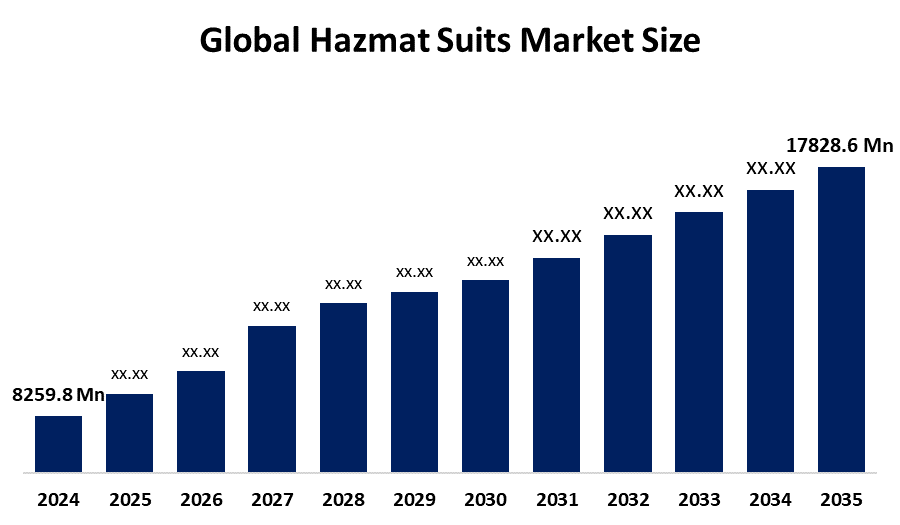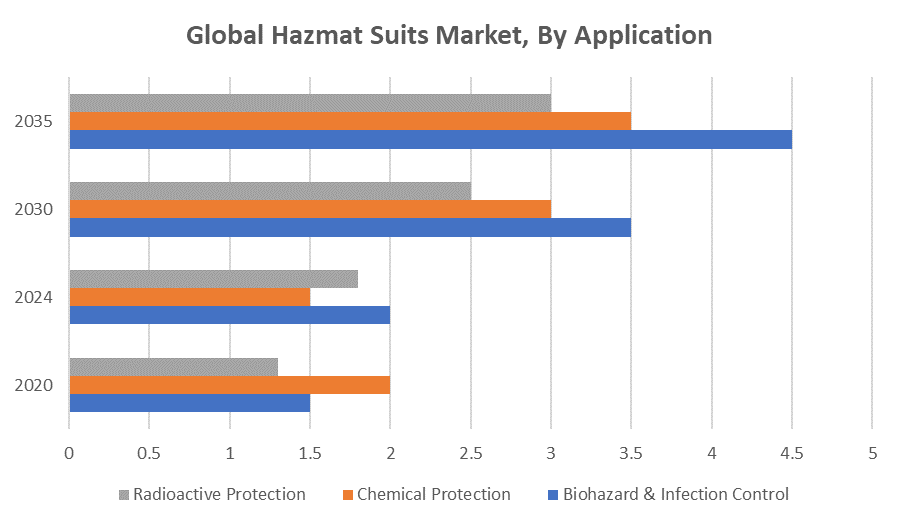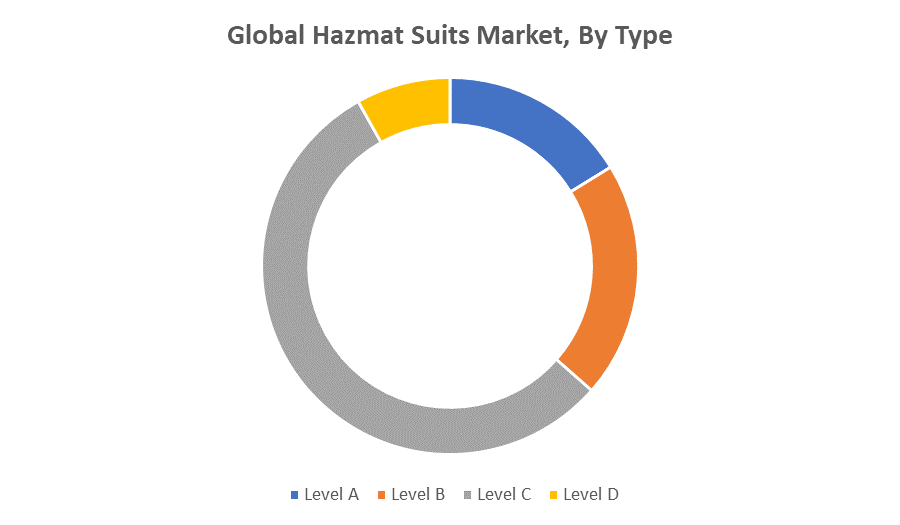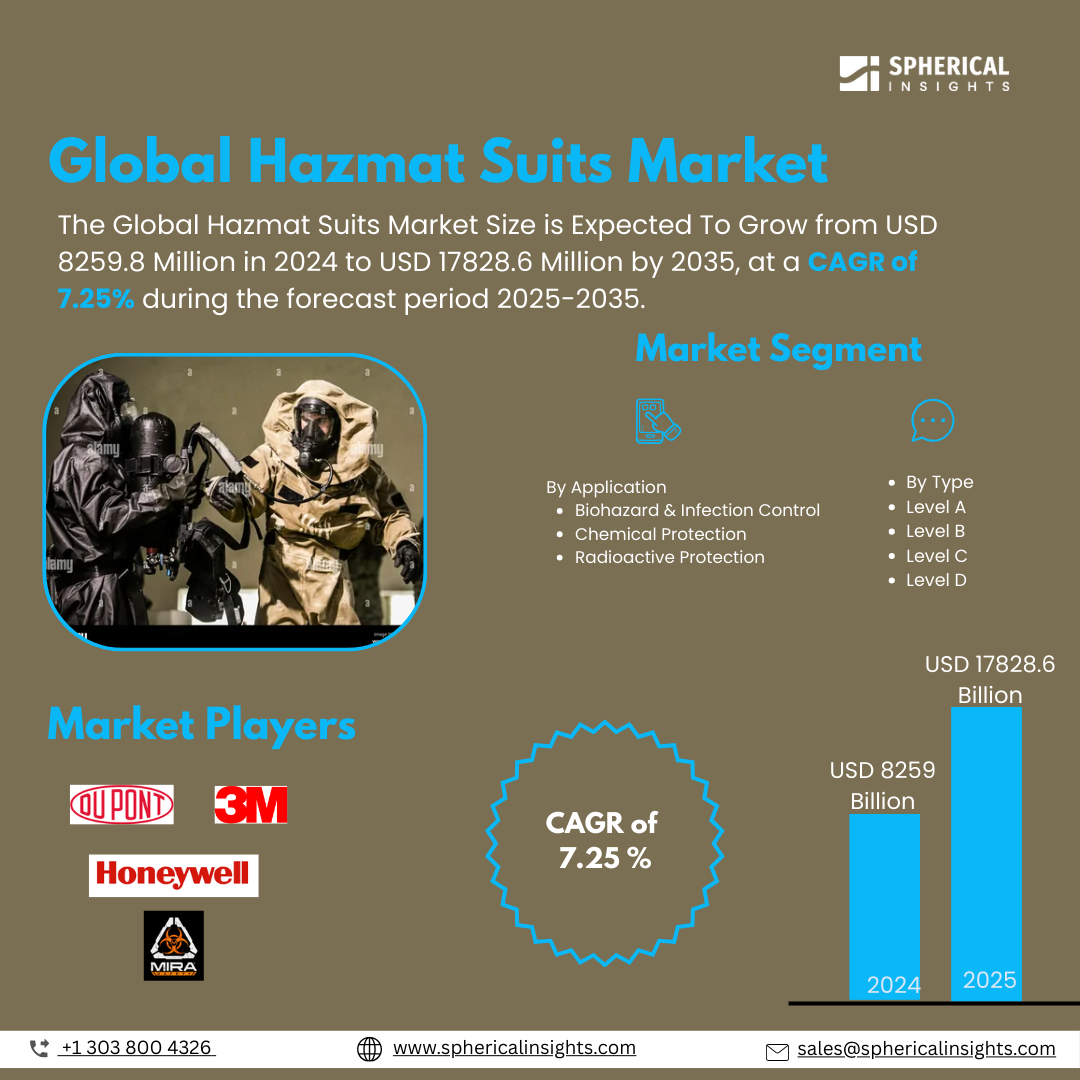Global Hazmat Suits Market Insights Forecasts to 2035
- The Global Hazmat Suits Market Size Was Estimated at USD 8259.8 Million in 2024
- The Market Size is Expected to Grow at a CAGR of around 7.25% from 2025 to 2035
- The Worldwide Hazmat Suits Market Size is Expected to Reach USD 17828.6 Million by 2035
- Asia Pacific is expected to grow the fastest during the forecast period.

Hazmat Suits Market
The Hazmat Suits Market Size involves the development and supply of protective garments designed to safeguard individuals from exposure to hazardous substances, including chemical, biological, radiological, and nuclear agents. These suits are essential in sectors such as healthcare, chemical manufacturing, emergency response, mining, and defense, where personnel are regularly exposed to potentially dangerous environments. Hazmat suits are categorized into different protection levels (A, B, C, and D), depending on the degree of protection required. They are typically made from advanced materials that provide durability, impermeability, and resistance to toxic agents. The market includes various suit types tailored for specific applications, such as gas-tight suits for chemical spills and splash protection suits for decontamination work. Key market participants focus on producing high-quality, comfortable, and functional suits that meet international safety standards. The demand for hazmat suits continues to grow steadily, driven by the need for reliable personal protective equipment in both routine operations and emergency situations.
Attractive Opportunities in the Hazmat Suits Market
- Tailoring hazmat suits to meet the specialized needs of industries like agriculture, pharmaceuticals, and nuclear facilities offers a chance to capture niche markets requiring unique protection levels.
- Incorporating sensors and smart features (e.g., temperature monitoring, exposure detection) in hazmat suits opens avenues for innovation and enhances user safety and operational efficiency.
- Improving industrial safety standards and increasing healthcare infrastructure investment in regions such as Latin America and Africa present untapped potential for market growth and large-scale procurement.
Global Hazmat Suits Market Dynamics
DRIVER: Increased focus on workplace safety
The Hazmat Suits Market Size is growing due to several important reasons. One major factor is the increased focus on workplace safety, with more industries following strict health and safety rules. Sectors like chemical manufacturing, oil and gas, and healthcare need reliable protective clothing to keep workers safe from dangerous substances. The spread of infectious diseases, such as COVID-19, has also led to higher demand for hazmat suits, especially in hospitals and emergency services. Governments and defense organizations are investing more in protective gear due to concerns about chemical and biological threats. At the same time, improvements in suit materials and design have made them lighter, more comfortable, and easier to wear for long periods. These advancements encourage more industries to use hazmat suits regularly. Overall, the need for better protection and safety in both everyday work and emergency situations is driving steady growth in the hazmat suits market.
RESTRAINT: High cost of advanced hazmat suits
One major challenge is the high cost of advanced hazmat suits, which can limit adoption, especially among small- and medium-sized organizations with limited budgets. The manufacturing process involves specialized materials and technology, contributing to these high costs. Additionally, hazmat suits can be uncomfortable to wear for long periods, especially in hot or physically demanding environments, which may reduce user compliance and effectiveness. Limited reusability and the need for proper training in donning and doffing suits also add to operational difficulties. Strict regulatory requirements and certification standards can delay the development and approval of new products. Furthermore, in regions with low awareness or weaker enforcement of safety regulations, the use of hazmat suits may remain limited. These factors collectively pose challenges to market expansion, particularly in developing regions and cost-sensitive industries where safety investments are often deprioritized.
OPPORTUNITY: Development of eco-friendly and reusable hazmat suits
One key opportunity lies in the development of eco-friendly and reusable hazmat suits, addressing environmental concerns and reducing long-term costs for end users. There is also increasing potential in customizing suits for specific industries, such as agriculture, pharmaceuticals, or nuclear facilities, where specialized protection is needed. The rise of automation and smart technology integration, such as sensors that monitor temperature or exposure levels, offers a new frontier for innovation in hazmat gear. Growing awareness and preparedness for natural disasters and bioterrorism threats are pushing governments and private organizations to expand emergency stockpiles, creating demand for large-scale procurement. Emerging markets, particularly in Latin America and Africa, offer untapped potential due to improving industrial safety standards and increased investment in healthcare infrastructure. These opportunities provide a pathway for manufacturers to diversify their offerings and expand their global presence.
CHALLENGES: Lack of uniform safety standards across different countries and industries
The hazmat suits market faces some important challenges. One of the biggest issues is the lack of uniform safety standards across different countries and industries, which makes it hard for companies to create suits that meet all requirements. Another problem is supplying chain disruptions, like shortages of materials or shipping delays, which can slow down production, especially during emergencies. Many users also lack proper training on how to use these suits correctly, which can reduce their effectiveness. Producing large quantities quickly while still keeping high quality is also difficult, especially when demand rises suddenly. In some cases, other types of protective gear might be chosen instead, especially if they are cheaper or easier to use. Finally, while innovation is important, it can be expensive, and smaller companies may struggle to keep up with larger competitors. These challenges make it harder for the market to grow smoothly and consistently.
Global Hazmat Suits Market Ecosystem Analysis
The global hazmat suits market ecosystem includes raw material suppliers, manufacturers like DuPont and 3M, regulatory bodies such as OSHA, distributors, and end-users from healthcare, defense, and industrial sectors. Technology partners drive innovation in materials and design, improving protection and comfort. Distributors ensure timely delivery, especially during emergencies. Training providers offer essential education on proper use and maintenance. This interconnected ecosystem relies on compliance with safety standards and adapts to changing demands from health crises, industrial growth, and technological advances, making it dynamic and essential for hazardous environment safety.
Based on the application, the biohazard & infection control segment led the market with a significant revenue share and is expected to grow at a remarkable CAGR over the forecast period

The biohazard and infection control segment dominates the hazmat suits market because it addresses critical safety needs in healthcare and related fields. Hazmat suits used in this segment protect medical staff, lab technicians, and emergency responders from exposure to dangerous pathogens like viruses, bacteria, and other infectious agents. The COVID-19 pandemic significantly increased awareness and demand for high-quality protective suits to prevent contamination and disease spread. This segment also includes suits used during outbreaks of diseases such as Ebola, SARS, and other biohazard emergencies. Hospitals and healthcare facilities continuously invest in protective gear to ensure the safety of their workers and patients. Additionally, strict regulations and protocols around infection control further boost demand. As global health concerns persist and biohazard threats evolve, the biohazard and infection control segment is expected to see steady growth, with innovations focusing on enhanced protection, comfort, and durability.
Based on the type, the level C segment led the market with the largest revenue share and is expected to grow at a substantial CAGR over the forecast period

The level C segment leads The Global HazmSuits Market Size with the largest revenue share. Level C suits provide a balanced combination of protection and comfort, making them suitable for many industrial and healthcare applications where airborne contaminants or liquid splashes are present but the highest level of respiratory protection isn’t required. These suits typically include full-body coverage with chemical-resistant materials and use air-purifying respirators, making them more affordable and easier to wear compared to Level A and B suits. Their versatility and cost-effectiveness drive strong demand across sectors such as chemical manufacturing, emergency response, and infection control. As industries continue to prioritize worker safety while managing costs, the Level C segment is expected to grow at a substantial compound annual growth rate (CAGR) over the forecast period, supported by increasing regulatory compliance and advancements in material technology.
North America is anticipated to hold the largest market share of the hazmat suits market during the forecast period
North America is anticipated to hold the largest market share in the hazmat suits market during the forecast period. This is largely due to the region’s stringent safety regulations, well-established industrial and healthcare sectors, and high awareness of workplace safety standards. Organizations such as OSHA enforce strict guidelines for personal protective equipment, driving consistent demand for high-quality hazmat suits. Additionally, the presence of major market players and advanced manufacturing capabilities in North America supports product innovation and availability. The region also invests heavily in emergency preparedness and biohazard management, further boosting demand across healthcare, chemical, and defense industries. These factors combined position North America as a dominant player in the global hazmat suits market.
Asia Pacific is expected to grow at the fastest CAGR in the hazmat suits market during the forecast period
Asia Pacific is expected to grow at the fastest CAGR in the hazmat suits market during the forecast period. This rapid growth is driven by increasing industrialization, expanding healthcare infrastructure, and rising awareness of workplace safety in countries like China, India, and Southeast Asia. Growing chemical manufacturing, oil and gas, and pharmaceutical sectors are fueling demand for protective gear. Additionally, improving regulatory frameworks and greater adoption of safety standards are encouraging more widespread use of hazmat suits. Investments in emergency response capabilities and biohazard protection are also contributing to market expansion. As a result, the Asia Pacific region offers significant opportunities for manufacturers and suppliers, making it the fastest-growing market globally.
Recent Development
- In November 2023, Ansell launched the AlphaTec® 58-700 Hazmat Suit, a lightweight and breathable suit providing protection against a wide range of hazardous materials.
- In January 2024, 3M initiated a recycling program for their disposable hazmat suits, aiming to reduce environmental impact by recycling suits into raw materials for new protective equipment.
Key Market Players
KEY PLAYERS IN THE HAZMAT SUITS MARKET INCLUDE
- DuPont
- 3M Company
- Honeywell International Inc.
- Lakeland Industries, Inc.
- Drägerwerk AG & Co. KGaA
- Kappler, Inc.
- Ansell Limited
- Mira Safety
- RZ Safety LLC
- Tychem
Market Segment
This study forecasts revenue at global, regional, and country levels from 2020 to 2035. Spherical Insights has segmented the hazmat suits market based on the below-mentioned segments:
Global Hazmat Suits Market, By Application
- Biohazard & Infection Control
- Chemical Protection
- Radioactive Protection
Global Hazmat Suits Market, By Type
- Level A
- Level B
- Level C
- Level D
Global Hazmat Suits Market, By Regional Analysis
- North America
- Europe
- Germany
- UK
- France
- Italy
- Spain
- Russia
- Rest of Europe
- Asia Pacific
- China
- Japan
- India
- South Korea
- Australia
- Rest of Asia Pacific
- South America
- Brazil
- Argentina
- Rest of South America
- Middle East & Africa
- UAE
- Saudi Arabia
- Qatar
- South Africa
- Rest of the Middle East & Africa






